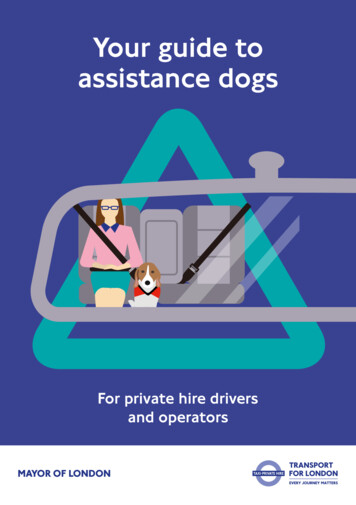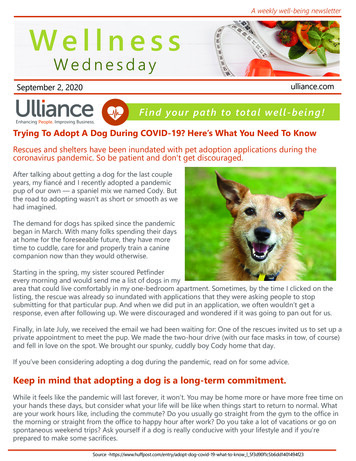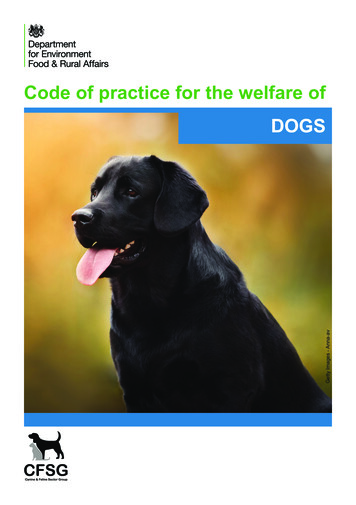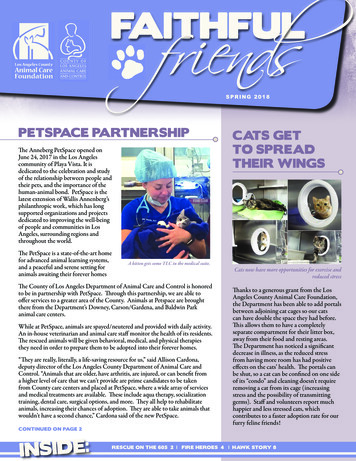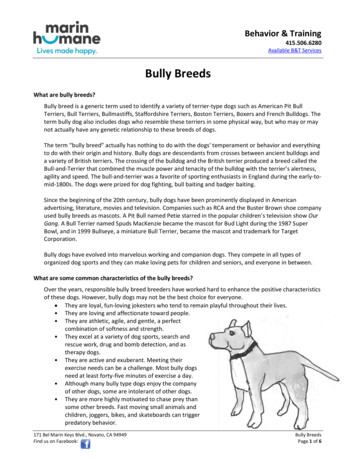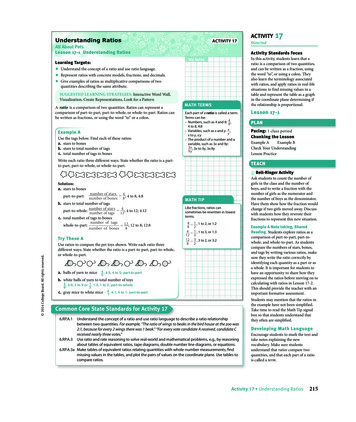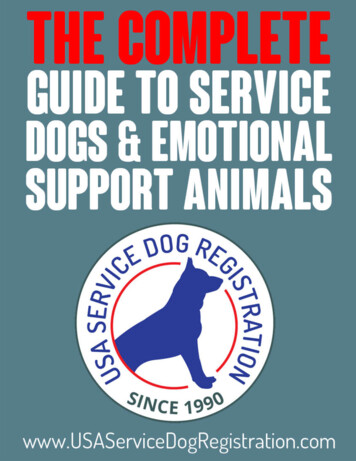
Transcription
ContentsI.WELCOME .pg.1II.SERVICE DOGS VS. EMOTIONAL SUPPORT ANIMALS .pg.2a. Service Dogs .pg.2b. Emotional Support Animals .pg.3III.WHAT THE FEDERAL LAWS SAY.pg.5a. The Americans With Disabilities Act .pg.5b. The Air Carrier Access Act . pg.9c. Fair Housing Act and Section 504 .pg.12IV.AIR ARY . .pg.20VIII.Limits of Liability/Disclaimer of Warranty .pg.21
To Service Dogs & Emotional Service Animals1WELCOMEThank you for requesting The Complete Guide To Service Dogs & EmotionalSupport Animals.USA Service Dog Registration created this guide to educate you about thedifferences between service dogs and emotional support animals (ESA) as wells asthe various federal and state laws surrounding service dogs and emotionalsupport animals.Since the general public is mostly uninformed about the rights of people withservice dogs and emotional support animals, it’s important for you to know yourrights.Our mission is to provide the awareness, services, and products to eliminatepotential conflicts and to ensure you’re not wrongly denied entry or access topublic establishments, airplanes, hotels, and housing.http://www.USAServiceDogRegistration.com 2016
To Service Dogs & Emotional Service Animals2SERVICE DOGS VS. EMOTIONAL SUPPORT ANIMALS (ESA)Service dogs and emotional support animals have very different jobs from each other and theterms are not interchangeable.SERVICE DOGSThe US government defines a “service animal” as a dog that has been individually trained to dowork or perform tasks for an individual with a disability, such as visual impairment, hearingimpairments, mental illnesses (such as post traumatic stress disorder (PTSD)), seizuredisorder, mobility impairment, and diabetes.The task(s) performed by the dog must be directly related to the person’s disability. The dogmust be trained to take a specific action when needed to assist the person with a disability.For example, a person with diabetes may have a dog that is trained to alert him when his bloodsugar reaches high or low levels. A person with depression may have a dog that is trained toremind her to take her medication. Or, a person who has epilepsy may have a dog that istrained to detect the onset of a seizure and then help the person remain safe during theseizure.Examples of such work or tasks include: guiding people who are blind alerting people who are deaf pulling a wheelchair alerting and protecting a person who is having a seizure reminding a person with mental illness to take prescribed medications calming a person with Post Traumatic Stress Disorder (PTSD) during an anxiety attackhttp://www.USAServiceDogRegistration.com 2016
To Service Dogs & Emotional Service Animals3Contrary to popular belief a service dog DOES NOT have to be trained by a professional servicedog trainer and CAN be trained by you according to the Americans with Disabilities Act (ADA).Under the American with Disabilities Act (ADA) service dogs in training are not consideredservice dogs and cannot be taken into public places. However, some State and local laws coveranimals that are still in training.EMOTIONAL SUPPORT ANIMALSAn emotional support animal (ESA) is a companion animal which has been prescribed by aperson’s licensed mental health professional (therapist, psychologist, or psychiatrist). Theanimal is part of the treatment program for this person and provides a therapeutic benefit,such as alleviating or mitigating some symptoms of the disability, to an individual with anemotional/psychological disability.Examples of such work or task include: Age-Related Cognitive Decline Any Psychiatric Condition (*see exclusions below) Autism Depression Dyslexia Bipolar Disorder Emotionally Overwhelmed Panic Attackshttp://www.USAServiceDogRegistration.com 2016
To Service Dogs & Emotional Service Animals 4Post Traumatic Stress Disorder (PTSD)Separation AnxietySocial PhobiaStress Problems* Exclusions to the Qualified Disability DefinitionNeither deviant behavior (e.g., political, religious, or sexual) nor conflicts that are primarilybetween the individual and society are mental disorders unless the deviance or conflict is asymptom of a dysfunction in the individual. According to Title II of the American withDisabilities Act of 1990, current or future interpretation of psychological disabilities excludescommon personality traits such as poor judgment or a quick temper.Emotional support animals are typically dogs and cats, but may include other animals. In orderto be prescribed an emotional support animal by a physician or other medical professional, theperson seeking such an animal must have a verifiable disability. To be afforded protectionunder United States federal law, a person must meet the federal definition of disability andmust have a note from a physician or other medical professional stating that the person hasthat disability and that the emotional support animal provides a benefit for the individual withthe disability. An animal does not need any specific training to become an emotional supportanimal.Click here to get your emotional support animal letter from a mental health com 2016
To Service Dogs & Emotional Service Animals5WHAT THE FEDERAL LAWS SAYThis section provides an overview of how three major Federal laws govern the rights of aperson requiring a service dog or Emotional Support Animal (ESA). In addition, many states alsohave laws that provide a different definition of “service animal”. You should check your state’slaw and follow the law that offers the most protection for service animals. The rules andallowances related to access with service animals will vary according to the law applied and thesetting.The Americans with Disabilities ActThe Americans with Disabilities Act (ADA) defines a service animal as any dog that is individuallytrained to do work or perform tasks for the benefit of an individual with a disability, including aphysical, sensory, psychiatric, intellectual, or other mental disability. Other species of animals,whether wild or domestic, trained or untrained, are not considered service animals. If theymeet this definition, dogs are considered service animals under the ADA regardless of whetherthey have been licensed or certified by a state or local government.Examples of animals that fit the ADA’s definition of “service animal” because they have beenspecifically trained to perform a task for the person with a disability: Guide Dog or Seeing Eye Dog is a carefully trained dog that serves as a travel tool forpersons who have severe visual impairments or are blind. Hearing or Signal Dog is a dog that has been trained to alert a person who has asignificant hearing loss or is deaf when a sound occurs, such as a knock on the door. Psychiatric Service Dog is a dog that has been trained to perform tasks that assistindividuals with disabilities to detect the onset of psychiatric episodes and lessen theireffects. Tasks performed by psychiatric service animals may include reminding thehandler to take medicine, providing safety checks or room searches, or turning on lightsfor persons with Post Traumatic Stress Disorder, interrupting self-mutilation by personswith dissociative identity disorders, and keeping disoriented individuals from danger. SSigDOG (sensory signal dogs or social signal dog) is a dog trained to assist a person withautism. The dog alerts the handler to distracting repetitive movements common amongthose with autism, allowing the person to stop the movement (e.g., hand flapping). Seizure Response Dog is a dog trained to assist a person with a seizure disorder. Howthe dog serves the person depends on the person’s needs. The dog may stand guardover the person during a seizure or the dog may go for help. A few dogs have learned topredict a seizure and warn the person in advance to sit down or move to a safe place.http://www.USAServiceDogRegistration.com 2016
To Service Dogs & Emotional Service Animals6Under the ADA, covered entities include State and local governments, nonprofit organizations,and privately owned commercial facilities (factories, warehouses, office buildings, etc ) andprivately owned businesses (restaurants, grocery stores, hotels, retail stores, shopping malls,taxicabs, theaters, concert halls, sports facilities, doctors’ offices, etc.) that serve the public.Entities controlled by religious organizations including churches, synagogues and mosques arenot covered. However, there may be State laws that apply to religious organizations. Inaddition private clubs are not covered, except to the extent that the facilities of the private clubare made available to customers of a place of public accommodation.A covered entity that serves the public generally must allow service dogs to accompany peoplewith disabilities in all areas of the facility where the public is normally allowed to go. Anindividual with a service dog may not be segregated from other customers. Though someservice dogs wear special collars and harnesses and some are licensed or certified and haveidentification papers, covered entities may not require documentation, such as proof that thedog has been certified, trained, or licensed as a service dog, as a condition for entry.To determine if a dog is a service dog, a covered entity may only ask two questions:1. Is this animal required because of a disability?2. What work or task has this animal been trained to perform?These questions may not be asked if the need for the service dog is obvious (e.g., the dog isguiding an individual who is blind or is pulling a person’s wheelchair). A covered entity may notask about the nature or extent of an individual’s disability or require documentation, such asproof that the dog has been certified, trained or licensed as a service dog, or require the dog towear an identifying vest. In addition, a covered entity cannot require that the dog demonstrateits task.Further it does not matter if a person has a note from a doctor that states the person has adisability and needs to have the animal for emotional support. A doctor’s letter can prescribean emotional support animal (ESA), but a doctor’s letter does not turn an animal into a serviceanimal. Only a dog that is individually trained (professionally OR by the handler) to do work orperform tasks for the benefit of an individual with a disability, including a physical, sensory,psychiatric, intellectual, or other mental disability is a service animal.The ADA does not require covered entities to modify policies, practices, or procedures if itwould “fundamentally alter” the nature of the goods, services, programs, or activities providedhttp://www.USAServiceDogRegistration.com 2016
To Service Dogs & Emotional Service Animals7to the public. Nor does it overrule legitimate safety requirements. If admitting service animalswould fundamentally alter the nature of a service or program, service animals may beprohibited. In addition, if a particular service animal is out of control and the handler does nottake effective action to control it, or if it is not housebroken, that animal may be excluded.In most settings, the presence of a service animal will not result in a fundamentalalteration. However, there are some exceptions. For example, at a boarding school, serviceanimals could be restricted from a specific area of a dormitory reserved specifically for studentswith allergies to dog dander. At a zoo, service animals can be restricted from areas where theanimals on display are the natural prey or natural predators of dogs, where the presence of adog would be disruptive, causing the displayed animals to behave aggressively or becomeagitated. They cannot be restricted from other areas of the zoo.The ADA does not restrict the type of dog breeds that can be service dogs. A service dog maynot be excluded based on assumptions or stereotypes about the dog's breed or how the dogmight behave. However, if a particular service dog behaves in a way that poses a direct threatto the health or safety of others, has a history of such behavior, or is not under the control ofthe handler, that dog may be excluded. If a dog is excluded for such reasons, staff must stilloffer their goods or services to the person without the dog present.Municipalities that prohibit specific breeds of dogs must make an exception for a service dog ofa prohibited breed, unless the dog poses a direct threat to the health or safety of others. Underthe “direct threat” provisions of the ADA, local jurisdictions need to determine, on a case-bycase basis, whether a particular service dog can be excluded based on that particular dog’sactual behavior or history, but they may not exclude a service dog because of fears orgeneralizations about how a dog or breed might behave.Mandatory registration of service dogs by a city or state is not permissible under theADA. However, service dogs are subject to the same licensing and vaccination rules that areapplied to all dogs.Service dogs are working dogs, not pets. The work or tasks a dog has been trained to providemust be directly related to the person's disability. Examples of work or tasks include, but arenot limited to: assisting individuals who are blind or have low vision with navigation and other tasks alerting individuals who are deaf or hard of hearing to the presence of people or sounds providing non-violent protection or rescue work pulling a wheelchairhttp://www.USAServiceDogRegistration.com 2016
To Service Dogs & Emotional Service Animals 8assisting an individual during a seizurealerting individuals to the presence of allergensretrieving items such as medicine or the telephoneproviding physical support and assistance with balance and stability to individuals withmobility disabilitieshelping individuals with psychiatric and neurological disabilities by preventing orinterrupting impulsive or destructive behaviorsThe ADA makes a distinction between psychiatric service dogs and emotional support animals.If the dog has been trained to sense that an anxiety attack is about to happen and take aspecific action to help avoid the attack or lessen its impact, that would qualify as a service dog.However, if the dog's mere presence provides comfort, that would not be considered a serviceanimal under the ADA.Service-dogs-in-training are not considered service dogs under the ADA. The dog must alreadybe trained before it can be taken into public places. However, some State or local laws coveranimals that are still in training.The crime deterrent effects of a dog’s presence and the provision of emotional support, wellbeing, comfort, or companionship are not considered work or tasks for purposes of thedefinition of a service dog and do not qualify as service dogs under the Americans withDisabilities Act (ADA).Other Provisions A public entity or private business is not responsible for the care and supervision of aservice animal. A public entity or private business shall not ask nor require an individual with a disabilityto pay a surcharge or deposit, even if people accompanied by pets are required to paysuch fees. If a public entity or private business normally charges individuals for the damage theycause, an individual with a disability may be charged for damage caused by his or herservice animal.Individuals who believe that they have been illegally denied access or service because they useservice animals may file a complaint with the U.S. Department of Justice. Individuals also havethe right to file a private lawsuit in Federal court charging the entity with discrimination underthe ADA.http://www.USAServiceDogRegistration.com 2016
To Service Dogs & Emotional Service Animals9While the ADA has a narrow definition of service animals that are permitted to be in places ofpublic accommodation, other laws still provide broader definitions in other areas.The Fair Housing Act (FHA) covers service animal provisions for residential housing situations,and the Air Carrier Access Act (ACAA) covers service animal provisions for airline travel. Thedefinition of a service animal under each of these laws is different than the definition under theADA. Some State and local laws also define service animal more broadly than the ADA does.Information about such laws can be obtained from the State Attorney General’s office.Air Carrier Access ActThe Department of Transportation’s Air Carrier Access Act (ACAA) has a broader definition of“service animal” than the Americans with Disabilities Act (ADA) does. The ACAA definitionincludes guide dogs, signal dogs, psychiatric service animals and emotional support animals orwhat we sometimes call comfort animals.The ACAA applies to persons with disabilities on aircraft and prohibits discrimination because ofdisability in air travel. It applies to all domestic airlines. Although there are some differences italso applies to foreign airlines that fly into or out of the United States. Airports themselves aregenerally covered under the ADA.An important note: the ACAA applies to persons with disabilities with a service animal OR withan emotional support animal. It only applies to persons with disabilities, and not to all personswith mental illness.Air carriers are required to allow service animals traveling with people with disabilities to sitwith them in the cabin of the aircraft. When you have a service dog or emotional supportanimal (ESA), the airlines are NOT allowed to charge you additional fees when your serviceanimal or ESA accompanies you. Though not required most airlines strongly recommend thatyou have ID cards and a service vest with patches.Click here to get your ID card and service vest with patches.Persons traveling with pets, as opposed to service animals or emotional support animals, do nothave any rights under the ACAA. Air carrier personnel may ask questions and requestdocumentations in certain circumstances to determine whether the person is entitled to travelwith the service animal.http://www.USAServiceDogRegistration.com 2016
To Service Dogs & Emotional Service Animals10It’s a common misconception among airline passengers that questions and documentation arenot allowed once you claim a disability. Depending on the person’s disability and the type ofservice animal, the questions that may be asked and the level of documentation that may berequired vary.The variation is because many people with disabilities who travel do not have obviousdisabilities and the need for a service animal is not apparent. The need for a service animalmay not be apparent even for some individuals with obvious disabilities.The airline should permit a service animal to accompany a person on the plane if the person hasan obvious disability and the animal is wearing a harness, tags, vest or a backpack, or theperson provides identification cards or other written documentation, or the person provideswhat the law calls credible, verbal assurances that the animal is a service animal.If airline personnel are not certain of the animal's status, even after being told that it's a serviceanimal, then personnel can ask things like, “What tasks or function does your animal performfor you?”; “What has the animal been trained to do for you?”; or “Would you describe how theanimal performs this task or function for you?”The rules are a little different for emotional support or psychiatric service animals. The airlinesmay request very specific documentation to be provided 48 hours in advance of the flight. Thedocumentation must be not more than one year old. It has to be on letterhead from a licensedmental health professional or medical doctor who is treating the individual’s mental healthrelated disability stating:1) The customer has a mental or emotional disability recognized in the Diagnostic andStatistical Manual of Mental Disorders - Fourth Edition (DSM-IV). The documentationDOES NOT need to state the person's diagnosis.2) The customer needs the emotional support of psychiatric service animal as anaccommodation for air travel and/or for activity at the passenger's destination3) The individual providing the assessment is a licensed mental health professional ormedical doctor, and the Passenger is under his or her professional care AND4) The date and type of mental health professional's or medical doctor's license and thestate or other jurisdiction in which it was issuedClick here to get your emotional support animal letter from a mental health com 2016
To Service Dogs & Emotional Service Animals11The purpose of the documentation is to prevent abuse by passengers that do not have amedical need for an emotional support animal and to ensure that passengers who have alegitimate need for emotional support animals are permitted to travel with their serviceanimals on the aircraft.Unusual animals like miniature horses, pigs, monkeys, etc may be allowed to travel as serviceanimals. It depends on a couple of different factors. The airline may take in to account theanimal's size, the animal's weight, and whether the animal would pose a direct threat to thehealth and safety of others or cause a significant disruption in cabin service. Also, if there arerestrictions on the animal at the final destination (i.e. going to another country) then theservice animal may be denied passage.Snakes, other reptiles, ferrets, rodents and spiders will be denied boarding the plane, as theymay pose other safety and public health concerns. Foreign carriers are required to transportonly dogs as service animals. If a service animal barks, growls, jumps on people, or misbehavesin ways that indicate that the animal has not been properly trained and has not been trained tobehave properly in public settings, or poses a direct threat to the health and safety of others, orposes a significant risk of disruption in airline service, the animal may be denied boarding.Therapy animals, which are pets that have been trained and registered by a therapyorganization in order to visit nursing homes, hospitals, schools and other facilities, are notconsidered to be service animals. When traveling with a therapy animal, standard pet-relatedregulations and restrictions will apply.Service animals cannot be denied passage because other customers are allergic to, annoyed by,or afraid of animals. The airlines will make accommodations to assure that other passengersare comfortable. If a passenger with a severe allergy that rises to the level of a disability cannottravel in the same cabin as the animal, a carrier may rebook one of the passengers on anotherflight.Passengers with the service animal may request pre-boarding and ask for a bulkhead seat or aseat that better suits their needs. A person traveling with a service animal may request anyseat unless it blocks an aisle or an area designated for emergency evacuation. If the personcannot be accommodated in a requested seat, then the person must be given the opportunityto move to another seat within the same class of service. The airline does not have to ask otherpassengers to give up all or most of the space in front of their seats to accommodate space fora service animal. The airline may try to find someone willing to do that, however.http://www.USAServiceDogRegistration.com 2016
To Service Dogs & Emotional Service Animals12The airline can voluntary upgrade a person traveling with a service animal to a business or firstclass seat to accommodate a service animal, but it is not required to do so. In-flight servicesand facilities do not have to be provided for service animals. Owners traveling with animalsmust provide for the animal's food, care, and supervision. In the airline terminal, though,airlines must provide animal-relief areas and must provide escort service to individuals travelingwith service animals to those areas when requested. Airlines are not required to makemodifications for service animals that would constitute an undue burden or wouldfundamentally alter their programs.FAIR HOUSING ACT and SECTION 504 OF THE REHABILITATION ACT OF 1973The Department of Housing and Urban Development’s Fair Housing Act (FHA) and Section 504of the Rehabilitation Act of 1973 (Section 504) have a broader definition of “service animal”than the Americans with Disabilities Act (ADA) does. To avoid confusion with the revised ADA"service animal" definition, the FHA uses the term "assistance animal" rather than “serviceanimal” to ensure that housing providers have a clear understanding of their obligations underthe FHA and Section 504.An assistance animal is not a pet. It is an animal that works, provides assistance, or performstasks for the benefit of a person with a disability, or provides emotional support that alleviatesone or more identified symptoms or effects of a person's disability. Assistance animals performmany disability-related functions, including but not limited to, guiding individuals who are blindor have low vision, alerting individuals who are deaf or hard of hearing to sounds, providingprotection or rescue assistance, pulling a wheelchair, fetching items, alerting persons toimpending seizures, or providing emotional support to persons with disabilities who have adisability-related need for such support.The ADA limits the definition of "service animal” under the ADA to include only dogs, andfurther defines "service animal" to exclude emotional support animals. This definition,however, does not limit housing providers' obligations to make reasonable accommodations forassistance animals under the FHA or Section 504. Persons with disabilities may request areasonable accommodation for any assistance animal, including an emotional support animal,under both the FHA and Section 504.In situations where the ADA and the FHA/Section 504 apply simultaneously (e.g., a publichousing agency, sales or leasing offices, or housing associated with a university or other placehttp://www.USAServiceDogRegistration.com 2016
To Service Dogs & Emotional Service Animals13of education), housing providers must meet their obligations under both the reasonableaccommodation standard of the FHA/Section 504 and the service animal provisions of the ADA.The reasonable accommodation provisions of both laws must be considered in situations wherepersons with disabilities use (or seek to use) assistance animals in housing where the providerforbids residents from having pets or otherwise imposes restrictions or conditions relating topets and other animals.For purposes of reasonable accommodation requests, neither the FHA nor Section 504 requiresan assistance animal to be individually trained or certified. While dogs are the most commontype of assistance animal, other animals can also be assistance animals.Housing providers are to evaluate a request for a reasonable accommodation to possess anassistance animal in a dwelling using the general principles applicable to all reasonableaccommodation requests. After receiving such a request, the housing provider must considerthe following:1. Does the person seeking to use and live with the animal have a disability — i.e., aphysical or mental impairment that substantially limits one or more major life activities?2. Does the person making the request have a disability-related need for an assistanceanimal? In other words, does the animal work, provide assistance, perform tasks orservices for the benefit of a person with a disability, or provide emotional support thatalleviates one or more of the identified symptoms or effects of a person's existingdisability?If the answer to question (1) OR (2) is "no," then the FHA and Section 504 do not require amodification to a provider's "no pets" policy, and the reasonable accommodation request maybe denied.Where the answers to questions (1) AND (2) are "yes," the FHA and Section 504 require thehousing provider to modify or provide an exception to a "no pets" rule or policy to permit aperson with a disability to live with and use an assistance animal(s) in all areas of the premiseswhere persons are normally allowed to go, unless doing so would impose an undue financialand administrative burden or would fundamentally alter the nature of the housing provider'sservices.Click here to get your emotional support animal letter from a mental health com 2016
To Service Dogs & Emotional Service Animals14Breed, size, and weight limitations may not be applied to an assistance animal.The request may also be denied if: (1) the specific assistance animal in question poses a directthreat to the health or safety of others that cannot be reduced or eliminated by anotherreasonable accommodation, or (2) the specific assistance animal in question would causesubstantial physical damage to the property of others that cannot be reduced or eliminated byanother reasonable accommodation.A determination that an assistance animal poses a direct threat of harm to others or wouldcause substantial physical damage to the property of others must be based on an individualizedassessment that relies on objective evidence about the specific animal's actual conduct — noton mere speculation or fear about the types of harm or damage an animal may cause and noton evidence about harm or damage that other animals have caused.Conditions and restrictions that housing providers apply to pets may not be applied toassistance animals. F
USA Service Dog Registration created this guide to educate you about the differences between service dogs and emotional support animals (ESA) as wells as . (ADA) service dogs in training are not considered service dogs and cannot be taken into public places. However, some State and local laws cover animals that are still in training.

